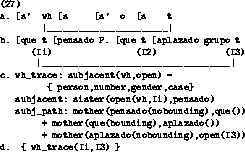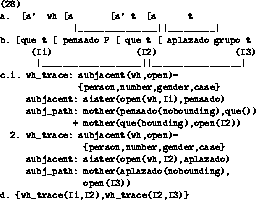


Next: The translation of Up: WH-Movement Previous: Introduction
Implementation
The structural relation for wh-movement should reflect the idea that the wh-constituent may bind across one bounding node at most. Note that, before and after the crossing of this bounding node, it may theoretically cross an unlimited number of nodes that are not bounding. The structural relation that reflects this idea looks like (26b), the wh-trace relation is defined in (26a).

The wh-trace relation is established by the structural relation
subjacent between a wh-element and an open slot.
The definition of the subjacent-relation closely resembles
that of c_command.
Instead of the relation 'ancestor', a relation 'subj_path' is defined that
specifies a path consisting of one bounding node at most.
Non-bounding nodes may invervene freely. Subjacency then is not
defined as a filter, it is a
positive formulation of possible relations.
Note that (26) is valid both for
languages in which S is a bounding node, such as English, and for
languages which have S-bar as bounding node. The difference in
boundedness will be expressed in the lexicon and the bindings will be
established according to the definition of subjacency
and given the boundedness
of particular nodes .
.
As has been shown in (25a) and (25b), the trace can always be bound in two ways in languages that have S-bar as a bounding node, provided there are at least two clauses in between the antecedent and the trace. We can make good use of this in MiMo. The Spanish synthesis component can check whether the comp-position of a clause is either filled or bound. If so, the clause is inverted. In this way, the variation in word order in Spanish wh-questions will be quite naturally accounted for.
This leaves us to show that our definition of wh-trace indeed establishes a relation in two different ways between the antecedent and the open position. (27b) shows the MiMo version of the structure in (27a). (27c) indicates the way in which the relation is found without binding the complementizer in the embedded clause. The relation 'sister' holds between the antecedent and the node 'pensado'. Ths node in its turn binds the open position I3, through mother-relations. The movement involves the crossing of one bounding node. (27d) indicates the relation found.

(28) shows that two relations can be found. The GB structure and the MiMo structure are shown in (28a) and (28b) respectively. In (28c1), the relation between I1 and I2 is found and (28c2) shows the one between I2 and I3. Both relations are mentioned in (28d).

In (28), the intermediate empty complementizer-position is bound,
hence inversion will take place. In (27) the complementizer is
neither filled nor bound, so no inversion in this case.
The data are accounted for in quite a natural and linguistically
sound way. They are the
direct consequence of the definitions of structural relations and
they do not have to be generated by some kind of arbitrary inversion
mechanism.



Next: The translation of Up: WH-Movement Previous: Introduction
Gertjan van Noord
Fri Nov 25 13:16:14 MET 1994